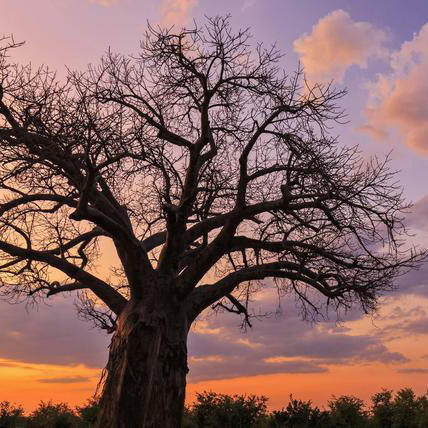Silent witnesses to climate change
Tagesspiegel Supplement - Paleobiologist Frank Riedel is researching what baobab trees tell us about the Earth's climate. The baobabs are his archive
May 31, 2021
It is a journey into past centuries. When Frank Riedel sets off for Namibia, Botswana and South Africa or when he flies to Oman, he travels with a team of researchers to the baobabs, the mighty trees of tropical Africa. He places the drill with the drill core, penetrates into the center of the trunk in sweaty collaborative work and finally removes a piece of wood in the shape of a long pencil - from this he can recognize annual rings that are up to 1000 years old.
The paleobiologist can use the samples to see, for example, how much the trees have grown during the rainy seasons. He can see how heavy the rainfall was, what dry seasons there must have been and whether these have become longer over the course of the epochs. “Baobabs function similarly to cacti,” says Riedel. “They can store water and survive long periods of drought.”
The scientist benefits from the fact that he is at home in several specialist disciplines for his research work: “Even when I was at school, I was a person with a wide range of interests,” says the 53-year-old. Sometimes he saw this as an obstacle, but mostly as an advantage. The decision to choose a single career was not easy for him.
Don't always just work in the laboratory
After graduating from high school, Frank Riedel initially went to sea with the German Navy. The then 18-year-old wanted to see the world and rarely went beyond the North and Baltic Seas. Traveling far away remained his dream, but after almost four years in the Navy, the first thing to do was to find the right course of study. Riedel decided to combine at least two of his interests: geology and biology.
In courses like “Microbiology,” he realized that he didn’t want to spend most of his professional life in the lab. “But I also realized that I wanted to work in an interdisciplinary manner,” remembers Riedel. He consistently aligned his scientific path accordingly. In Hamburg he wrote his doctorate in the Department of Geosciences and then defended it in the Department of Biology.
In January 2001, the Free University of Berlin appointed Frank Riedel to the Department of Geosciences in Lankwitz - the professor brought his own specialty, paleobiology, with him. Riedel says it's not just about researching and teaching historical biology: "Researching fossils produces a picture of the past with large gaps because only a few living creatures have been preserved as fossils." That's why his approach is - and that from some colleagues – to draw conclusions about the evolutionary history of recent species, i.e. species that are still alive or have recently become extinct.

Frank Riedel wants to draw conclusions about the evolutionary history of species that are still alive or have recently become extinct. © Lennart Paul
Is paleobiology a science focused on the past? Not at all, as the Baobab Project shows: Frank Riedel and his colleagues, Gerd Helle from the German Georesearch Center in Potsdam and Uwe Heußner from the German Archaeological Institute, do not want to follow the research results of the mathematicians, physicists and meteorologists who are currently determining the debate about climate change add important facet. “Meteorologists can only go back 130 to 140 years in their observations,” says Riedel. “That is far too short a period of time for researching long-term climate patterns.”
Major droughts in southern Africa may occur about every 70 years, which is why meteorologists recorded them exactly once in their records: “Of course, this is not a pattern, it doesn't reveal anything about whether the drought really occurs regularly and what is behind it,” says Riedel. Major droughts in southern Africa may occur about every 70 years, which is why meteorologists recorded them exactly once in their records: “Of course, this is not a pattern, it doesn't reveal anything about whether the drought really occurs regularly and what is behind it,” says Riedel. The current climate models for Africa are based on too little data and are therefore subject to serious errors. “But climate protection policy is based on these models.”
Changes are best seen in the outskirts of a climate zone
Since his appointment at the Free University of Berlin, Frank Riedel has been concerned with which natural “climate archives” go back far into the past and at the same time can show climate variability within a year or even a season. In 2010, Riedel discovered the baobabs for his research - partly because a colleague had proven that the legendary African baobab trees can live up to 2,000 years.
Baobabs shrink during the dry season and they swell during the rainy season. These differences can be detected over centuries using so-called dendrochronological methods that involve isotope geochemistry.
To do this, Frank Riedel regularly travels through southern Africa. But there are also baobabs in the Dhofar Mountains in Oman because the monsoon rainfall reaches there. “It is precisely in these peripheral areas of a climate zone that you can see changes best,” he says. The climate researchers from Germany work with local partners in all countries. These also help to contact village communities and explain to them why the scientists want to drill into a centuries-old baobab in their region.
If the work of Frank Riedel and his colleagues is successful, a climate archive for southern Africa will soon exist. Then not only could statements be made about developments over the past centuries, but regional changes could also be recorded. “Of course, the climate does not change equally in all places,” says Riedel. “Looking at each region separately is very complex. But this is the only way to do justice to the claim of giving people a serious forecast about the future climate of their region.”
Lennart Paul
